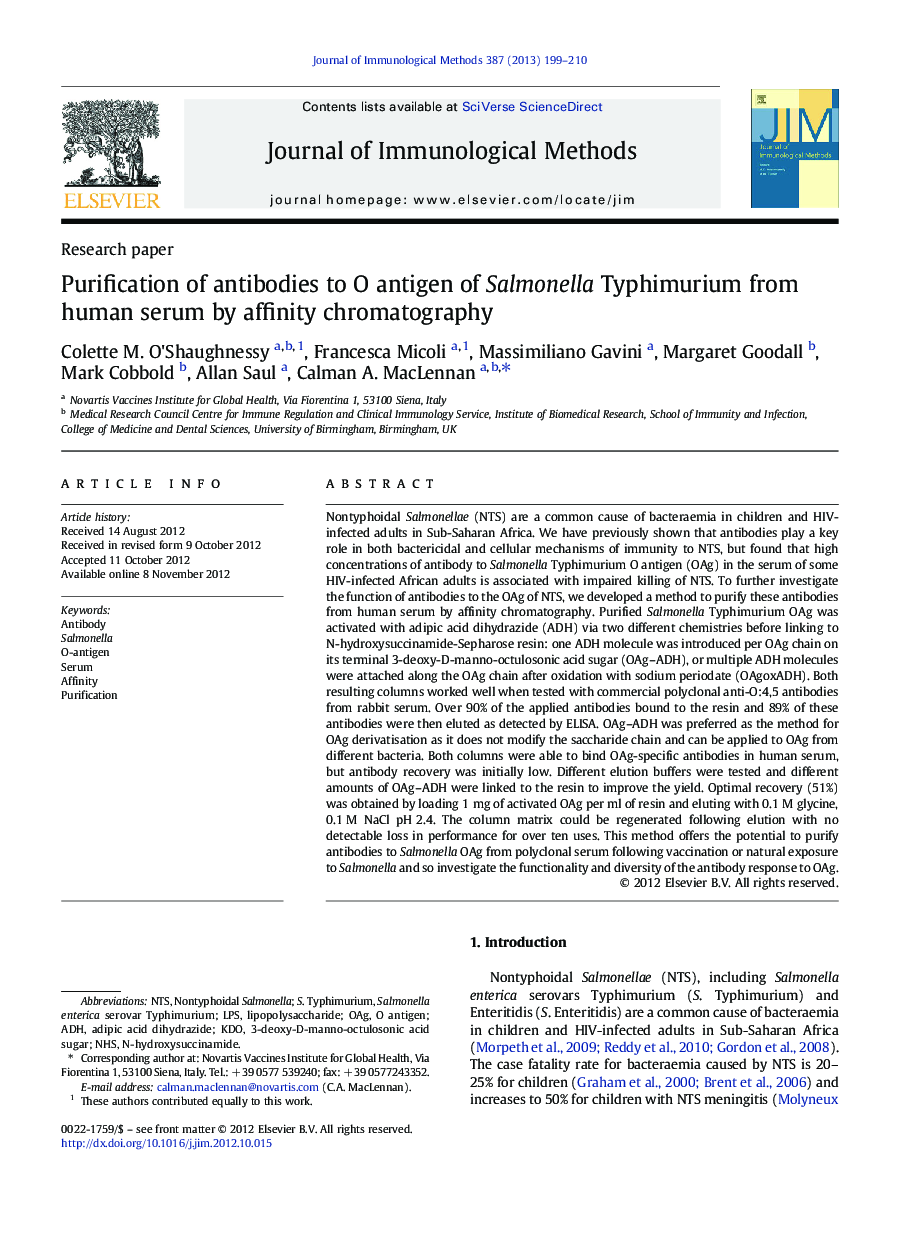| کد مقاله | کد نشریه | سال انتشار | مقاله انگلیسی | نسخه تمام متن |
|---|---|---|---|---|
| 8418477 | 1545720 | 2013 | 12 صفحه PDF | دانلود رایگان |
عنوان انگلیسی مقاله ISI
Purification of antibodies to O antigen of Salmonella Typhimurium from human serum by affinity chromatography
دانلود مقاله + سفارش ترجمه
دانلود مقاله ISI انگلیسی
رایگان برای ایرانیان
کلمات کلیدی
LPSSalmonella enterica serovar TyphimuriumOAGNHSNTSS. TyphimuriumADHKDO - WHOO antigen - آنتی ژن OO-antigen - آنتی ژن OAdipic acid dihydrazide - دی دی هیدرازید اسید ادیپSalmonella - سالمونلاNontyphoidal Salmonella - سالمونلا غیر سمیSerum - سرمlipopolysaccharide - لیپوپلی ساکاریدAffinity - وابستگیAntibody - پادتَن یا آنتیبادیPurification - پاکسازی
موضوعات مرتبط
علوم زیستی و بیوفناوری
بیوشیمی، ژنتیک و زیست شناسی مولکولی
بیوتکنولوژی یا زیستفناوری
پیش نمایش صفحه اول مقاله

چکیده انگلیسی
Nontyphoidal Salmonellae (NTS) are a common cause of bacteraemia in children and HIV-infected adults in Sub-Saharan Africa. We have previously shown that antibodies play a key role in both bactericidal and cellular mechanisms of immunity to NTS, but found that high concentrations of antibody to Salmonella Typhimurium O antigen (OAg) in the serum of some HIV-infected African adults is associated with impaired killing of NTS. To further investigate the function of antibodies to the OAg of NTS, we developed a method to purify these antibodies from human serum by affinity chromatography. Purified Salmonella Typhimurium OAg was activated with adipic acid dihydrazide (ADH) via two different chemistries before linking to N-hydroxysuccinamide-Sepharose resin: one ADH molecule was introduced per OAg chain on its terminal 3-deoxy-D-manno-octulosonic acid sugar (OAg-ADH), or multiple ADH molecules were attached along the OAg chain after oxidation with sodium periodate (OAgoxADH). Both resulting columns worked well when tested with commercial polyclonal anti-O:4,5 antibodies from rabbit serum. Over 90% of the applied antibodies bound to the resin and 89% of these antibodies were then eluted as detected by ELISA. OAg-ADH was preferred as the method for OAg derivatisation as it does not modify the saccharide chain and can be applied to OAg from different bacteria. Both columns were able to bind OAg-specific antibodies in human serum, but antibody recovery was initially low. Different elution buffers were tested and different amounts of OAg-ADH were linked to the resin to improve the yield. Optimal recovery (51%) was obtained by loading 1Â mg of activated OAg per ml of resin and eluting with 0.1Â M glycine, 0.1Â M NaCl pHÂ 2.4. The column matrix could be regenerated following elution with no detectable loss in performance for over ten uses. This method offers the potential to purify antibodies to Salmonella OAg from polyclonal serum following vaccination or natural exposure to Salmonella and so investigate the functionality and diversity of the antibody response to OAg.
ناشر
Database: Elsevier - ScienceDirect (ساینس دایرکت)
Journal: Journal of Immunological Methods - Volume 387, Issues 1â2, 31 January 2013, Pages 199-210
Journal: Journal of Immunological Methods - Volume 387, Issues 1â2, 31 January 2013, Pages 199-210
نویسندگان
Colette M. O'Shaughnessy, Francesca Micoli, Massimiliano Gavini, Margaret Goodall, Mark Cobbold, Allan Saul, Calman A. MacLennan,